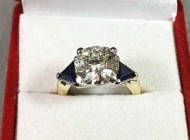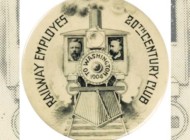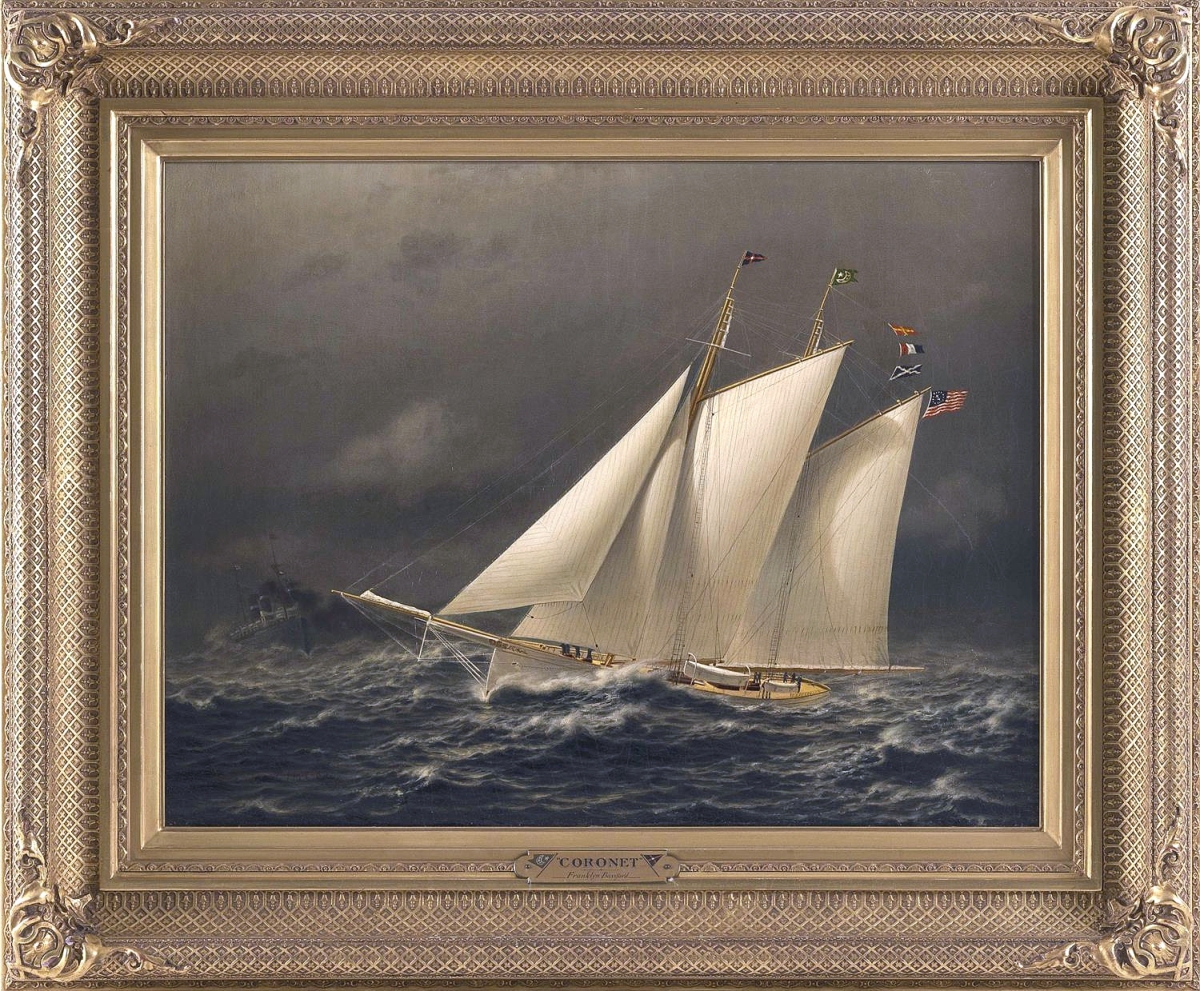
The sale’s top lot was “Coronet Underway” by Franklyn Bassford (American, 1857-1897), which brought $28,750. The work was completed in 1895, two years before the artist ended his own life. It was presumably commissioned by the ship’s then-owner, Arthur Curtiss James, one of the wealthiest Americans in his day who owned railway stock and mining interests.
Review by Greg Smith, Photos Courtesy Eldred’s
EAST DENNIS, MASS.- Eldred’s Marine Sale that ran April 29-30 was a catalog lush with treasures that emphasized the paradigm of design that emerged from business and sport on the high sea: sometimes things were slow, other times they were quite fast. Found within were images of some of the world’s fastest ships and artifacts of the sailing industry’s quietest moments.
Eldred’s president Josh Eldred said the sale grossed $750,000.
Fine art was led by “Coronet Underway,” an 1895 oil on canvas by New York artist Franklyn Bassford (1857-1897), which brought $28,750. The Coronet is still in service today after a restoration, but was once among the most famous ships in the world, particularly when the New York Times devoted its entire front page to the schooner in 1887 when its then owner, Rufus T. Bush, an oil tycoon, won a $10,000 challenge against Caldwell Hart Colt’s Dauntless in a transatlantic race. At the time of this painting, the yacht was owned by Arthur Curtiss James, said to be the largest private owner of railroad stock in the United States at the time and, as a result, among its wealthiest citizens.
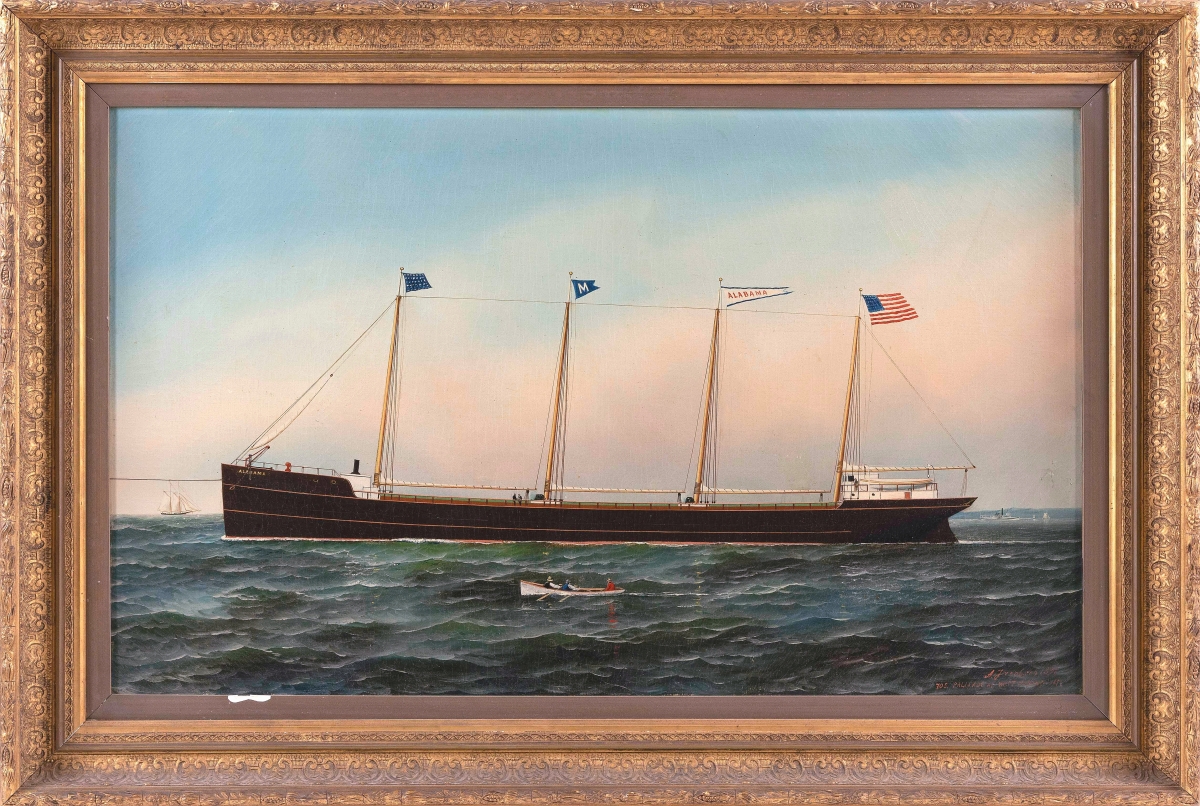
Antonio Nicolo Gasparo Jacobsen’s (1850-1921) top lot was found in the 22-by-36-inch “The Four-masted Steam/sail Schooner Alabama,” which took $17,500. Eldred’s noted that the ship was built at Harlan & Hollingsworth at Wilmington, Delaware for W.D. Munson of New York in 1873. Kelton collection.
Antonio Nicolo Gasparo Jacobsen’s (1850-1921) hand was on a number of top earners, including a $17,500 result for “The Four-Masted Steam/Sail Schooner Alabama.” The 22-by-36-inch oil on canvas was painted in 1891, ten years before the ship went out of service. The work came from the formidable collection of Richard Kelton, whose Kelton Foundation aimed to promote the stewardship, enhancement and understanding of maritime history through its collections of maritime art, navigational instruments, China Trade goods, Pacific tribal ethnographic materials and Aboriginal art. Other Jacobsens included an $11,875 result for “The American Steamship St. Croix” and $6,875 for “The Steamer Oceanic.”
As seen in Eldred’s August, 2020 sale and noted in that review in Antiques and The Arts Weekly, Kelton had a fine appreciation for the Yorke family of painters, which included William Gay (1817-1888), his wife Mary E. (1854-1893) and son William H. (1847-1921). An oil on canvas from William and Mary titled “America’s Cup 1887, Volunteer vs. Thistle, Race 2,” sold for $11,250. Behind came William Gay’s “Dauntless And Mohawk Racing, October 26, 1875,” an oil on canvas of 25¾ by 36 inches that brought $8,750. That year, the New York Yacht Club created a series of match races for members that saw Vice Commodore William T. Garner and the Mohawk race against ex-Commodore James Gordon Bennett and his schooner Dauntless. The latter won. Also from William Gay was “Sarah Neumann Inbound Off The Skerries,” a 24-by-36-inch oil on canvas that took $5,000. The depiction of the underwater shape of the rudder and hull at the stern, combined with a printed signature, suggested to Eldred’s that the artist’s son, William H., may have been involved in its production.
Eldred said Kelton’s collection will form the base of the firm’s summer sale and possibly one other.
Scrimshaw was represented by works from a Nantucket collection and others that had one-time provenance back to the Barbara Johnson collection.

Richard Kelton had a formidable collection of half hull models. This example, a model of the schooner yacht America, brought $16,250. It was attributed to George L. Watson (Scotland, 1851-1904). Eldred’s called the America among the most famous racing yachts ever and the first winner of the America’s Cup.
Notable here was a tooth attributed to The Arch Engraver that related to three others Eldred’s handled in 2017 from the Thomas Mittler collection. “Those three teeth were from the same jawbone and the scenes on them correlate with each other, relaying the story of a whale capture,” the firm wrote. “It is possible this tooth is from the same jawbone, given it is nearly the same shape and size as the others, and that it depicts two more scenes from the same ‘story.'” The tooth sold for $12,500 to the same collector who purchased the prior three in 2017. Head of marketing Cheryl Stewart, who catalogs much of the scrimshaw, said she was not aware of any other series of teeth that tell a singular story.
“There’s nothing known about the artist,” Stewart said, relating Nina Hellman said the same thing in her 2015 title Through the Eyes of a Collector. “It depicts a typical whale hunt: there’s the ship under sail, then the boats in the water in pursuit of a pod, then some close-up scenes of the sailors harpooning the whale, and then more.” Asked if there were any gaps in the story, any teeth possibly missing, she said, “It’s hard to tell. It appears to be a pretty complete story in and of itself, but how detailed it was and how many parts of the hunt is unknown.”
At $11,250 was a polychrome tooth by The Banknote Engraver depicting a naval battle believed to be the 1812 confrontation between the USS Constitution and the HMS Guerriere. The obverse features an oval bust of a female woman with a feathery border, a hallmark of the engraver’s work, according to Stewart. “The very finely detailed engraving and the flourishes, like you would see on a dollar bill, are all consistent across this carver’s workmanship,” she said. “The portrait is very typical of his work, though a battle scene is somewhat unusual.” The firm wrote the naval battle was similar to a scene in Abel Bowen’s Naval Monument, which served as a point of source material for scrimshanders. Furthermore, the image on the reverse is nearly identical to another tooth by the engraver illustrated in Ingenious Contrivances, Curiously Carved by Stuart M. Frank.
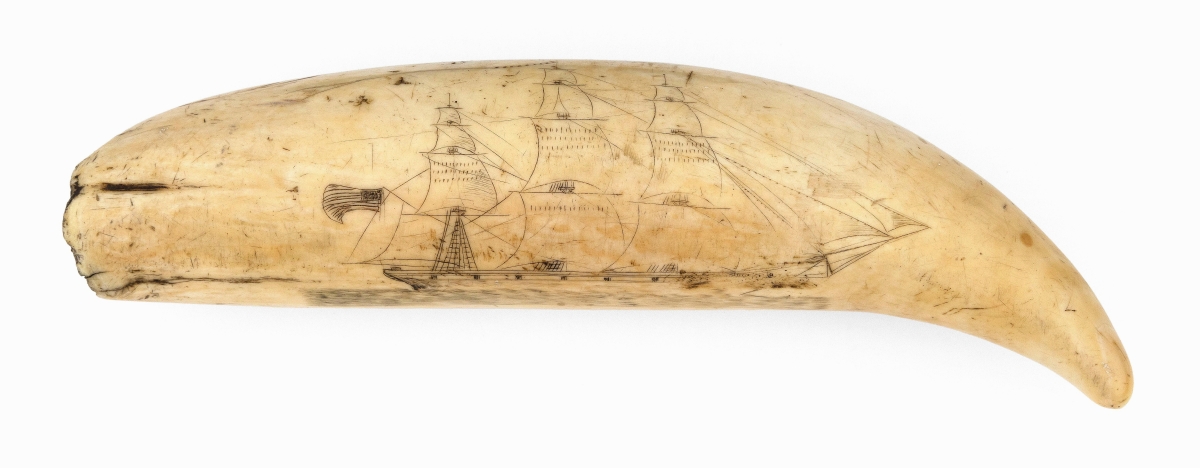
Among the only series of scrimshawed teeth that tell a singular story, this tooth attributed to The Arch Engraver went out at $12,500. Eldred’s sold three other teeth believed to be from the same hand, series and jawbone in a 2017 sale from the Mittler collection. The same collector purchased this and now has all four known examples. The full story tells the tale of a whale hunt, including scenes of sailing, pursuing a pod, harpooning a whale, etc.
“Scrimshaw artists took a lot of inspiration from publications and period magazines and books,” Stewart said.
With prior provenance to the Johnson collection was a pair of polychrome whale’s teeth, each featuring a young girl with her dog in acts of “Fidelity” and “Gratitude.” They sold for $5,312. The Johnson collection auction catalog attributes the teeth to Edward Penniman of Eastham, Mass. Eldred’s said the images are based on marble sculptures by Giovanni Maria Benzoni (Italy, 1809-1873), illustrated in the June 7, 1851 issue of The Illustrated London News. Penniman was a successful whaler whose home still stands on Fort Hill in Eastham, now run by the National Park Service as a museum. A whale jaw bone forms an entrance gate today just as it did then. At the same price was another tooth with tags to the Johnson collection that also had roots in Italian art: an example carved with a scene from the Italian love story Malgherita Spoletina. The tooth depicts the moment the religious recluse Theodore finds Malgherita after she drowned.
All prices quoted include buyer’s premium. For more information, www.eldreds.com or 508-385-3116.



















